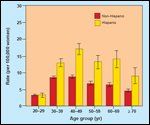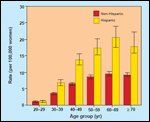Invasive Cervical Cancer Among Hispanic and Non-Hispanic Women-United States, 1992–1999
During 1973–1999, both the incidenceof and death rates forcervical cancer decreased byapproximately 50% in the UnitedStates. For 2002, approximately13,000 new cases of invasive cervicalcancer are expected, and approximately4,100 women will die of the disease.Although invasive cervical cancer canbe prevented by regular screening, theprevalence of Pap testing remains relativelylow among minority populationssuch as Hispanic women.
During 1973-1999, both the incidence of and death rates for cervical cancer decreased by approximately 50% in the United States. For 2002, approximately 13,000 new cases of invasive cervical cancer are expected, and approximately 4,100 women will die of the disease. Although invasive cervical cancer can be prevented by regular screening, the prevalence of Pap testing remains relatively low among minority populations such as Hispanic women.
To characterize the incidence of invasive cervical cancer, the Centers for Disease Control and Prevention (CDC) analyzed incidence data for Hispanic and non-Hispanic women during 1992-1999 in 11 geographic areas with population-based registries. This report summarizes the results of this analysis, which indicate that the incidence of invasive cervical cancer decreased for Hispanic and non-Hispanic women. However, among women aged ≥ 30 years, cervical cancer incidence for Hispanic women was approximately twice that for non-Hispanic women. To lower the incidence of invasive cervical cancer, local health organizations should provide culturally appropriate public health interventions that encourage participation in readily accessible cervical cancer-screening programs.
SEER Data
Data were obtained from the Surveillance, Epidemiology, and End Results (SEER) Program of the National Cancer Institute. Microscopically confirmed invasive cervical cancer cases (International Classification of Diseases for Oncology, 2nd ed, codes C532-C539) were selected. SEER Stat version 4.2 was used to compute incidences per 100,000 women and ageadjusted to the 2000 US standard population by 5-year age groups. To test for significant trends, linear regression was used to determine the estimated annual percent change (EAPC) and the 95% confidence interval (CI). The chi-square test was used to determine whether differences in incidences were significant. Invasive disease confined to the cervix was categorized as localized; cancers that had spread beyond the cervix to regional nodes or metastasized to other sites were categorized as advanced.
TABLE 1

Incidence of Invasive Cervical Cancer Among Hispanic and Non-Hispanic Women, by Stage and Diagnosis
During 1992-1999, a total of 14,759 invasive cervical cancer cases were diagnosed (53% localized, 40% advanced, and 7% unstaged). After excluding 235 cases of persons with unknown ethnicity, the analysis included data from 14,524 invasive cervical cancer cases; 3,166 (22%) were among Hispanic women, and 11,358 (78%) were among non-Hispanic women.
The incidence for invasive cervical cancer was 16.9 per 100,000 women (95% CI = 16.2-17.5) for Hispanic women and 8.9 (95% CI = 8.8-9. 1) for non-Hispanic women (Table 1).
Highest Incidence
Regardless of the stage of disease at diagnosis, incidences for Hispanic women were approximately twice those for non-Hispanic women in each year during 1992-1999 (Table 1). Overall incidences significantly decreased an average of 4.4% per year for Hispanic women and 2.0% per year for non-Hispanic women (Table 1). Incidences of localized-stage cancer declined 3.3% per year for Hispanic women (EAPC = -3.3; 95% CI = -6.0 to -0.6); the decline for non-Hispanic women was not significant (EAPC = -1.3; 95% CI = -2.9 to 0.4). Incidences of advanced-stage cancer declined 4.5% per year for Hispanic women (EAPC = -4.5; 95% CI = -6.9 to -2.0); the decline for non-Hispanic women was not significant (EAPC = -2.1; 95% CI = -4.4 to 0.2).
FIGURE 1

Localized Cervical Cancer
Analyses of invasive cervical cancer incidences by age and stage at diagnosis indicated that, except for women aged 20 to 29 years, incidences for Hispanic women were significantly higher than for non-Hispanic women, regardless of stage at diagnosis (Figures 1 and 2). For both Hispanic and non-Hispanic women, approximately 30% of all new invasive cervical cancers diagnosed among women aged < 50 years were at an advanced stage; among women who were aged ≥ 50 years, advancedstage cervical cancer represented 52% of new diagnoses.
Editorial Note From the CDC
The findings in this report indicate that in a population defined by 11 SEER registry areas, overall incidences of invasive cervical cancer are decreasing but that incidences remain relatively high for Hispanic women aged ≥ 30 years and for non-Hispanic women aged ≥ 50 years. The findings also indicate that women who have cervical cancer diagnosed at age ≥ 50 years are more likely to have advanced- stage cervical cancer.
Analyses of cervical cancer incidence by stage at diagnosis contribute to the assessment of the impact of screening programs. Cervical cancer screening identifies precancerous lesions and prompts early treatment to prevent advanced-stage disease and death. Risk factors for cervical cancer include early onset of sexual activity, multiple sex partners, human papillomavirus infection, and smoking. However, the most important determinant of invasive cervical cancer occurrence is infrequent or no cervical cancer screening.
FIGURE 2

Advanced Cervical Cancer
The decrease in incidence of localized and advanced-stage cervical cancer for both Hispanic and non- Hispanic women in the United States reflects the widespread use of cervical cancer-screening services. Recent data indicate that increases in cervical cancer screening are greater for Hispanics than for non-Hispanics (National Cancer Institute, Division of Cancer Control and Population Science, unpublished data, 2002). To increase access to screening services for women who lack health insurance or who are underinsured, the Breast and Cervical Cancer Mortality Prevention Act was enacted in 1990. During the 1990s, all states, territories, and Indian tribes, in collaboration with the CDC, established cervical cancer-screening programs.
Screening Practices
Hispanics constitute the largest ethnic minority group in the United States, representing 12.5% of the general population (2000 US Census Bureau at: http://factfinder.census. gov). Overall, the incidence of cancer among Hispanics differs from that of other US population groups. For invasive cervical cancer, analyses of the SEER data for 1988-1992 indicated that the incidence for Hispanic women was second only to that of Vietnamese women, which was more than twice the incidence for Hispanics. Analysis of the 1998 National Health Interview Survey indicated that the prevalence of Pap testing in the preceding 3 years was 80% for non-Hispanic white women, 83% for non-Hispanic black women, and 74% for Hispanic women.
Barriers to using screening services among Hispanic women include older age, less advanced education, low household income, and lack of health insurance. Nonuse of other screening tests and unrecognized sociocultural factors also might play a role. Research is needed to better understand barriers to screening practices.
The higher incidence of invasive cervical cancer among both Hispanic and non-Hispanic women aged ≥ 50 years and the greater likelihood that they have advanced disease might be a result of the low use of screening services among this population. Across all states, the use of Pap tests ranged from 84% to 93% among women of reproductive age (aged 18- 44 years) and from 75% to 91% among older women.
Limitations of the Report
The findings in this report are subject to at least three limitations. First, SEER registries cover approximately 14% of the US population and might not be representative of the general US population. Second, although the US Hispanic population comprises diverse communities, Hispanics identified by SEER registries represent 25% of the US Hispanic population and are largely of Mexican origin. Third, the classification "non-Hispanic women" includes other minority groups (eg, Asian/Pacific Islanders and blacks) who also have high incidences of cervical cancer.
In the United States, the use of Pap tests has had an important impact on cervical cancer morbidity and mortality. The findings in this report suggest that Hispanic women aged ≥ 50 years need to have improved access to screening services. To decrease the incidence of advanced- stage cervical cancer, public health programs should target women with culturally appropriate interventions that encourage screening. For women with abnormal Pap test results, appropriate diagnostic and treatment services also should be accessible.
Newsletter
Stay up to date on recent advances in the multidisciplinary approach to cancer.
2 Commerce Drive
Cranbury, NJ 08512
All rights reserved.